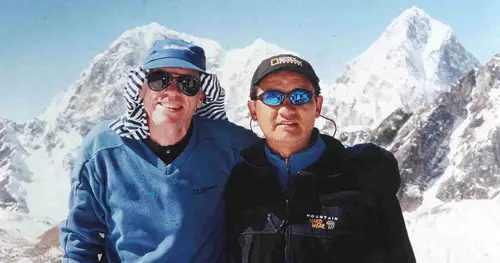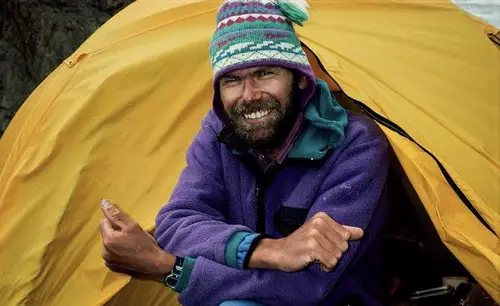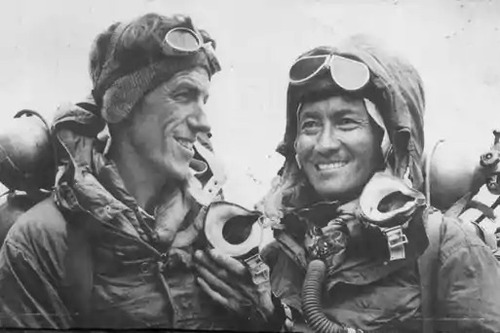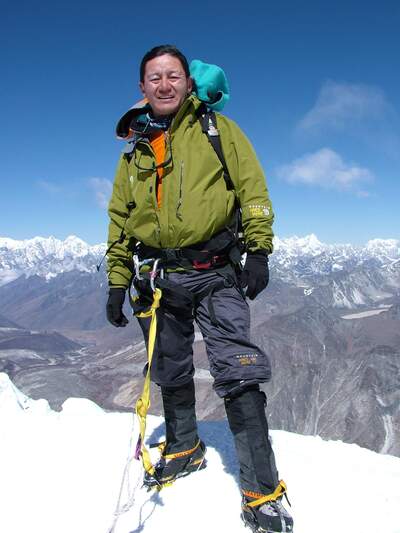Jamling Tenzing Norgay is a person from India and Nepal who climbed Mount Everest, the tallest mountain in the world. He is also a guide, writer, and speaker who motivates others. In 1953, his father, Tenzing Norgay, and Sir Edmund Hillary were the first to reach the top of Mount Everest.
Jamling’s family has a strong climbing tradition, and many of his relatives have also reached the summit of Mount Everest. He feels a strong connection to the Himalayan region and its tall peaks. Because of his skill in mountaineering, he is in high demand as a guide, leading both beginners and experienced climbers in the challenging mountains.
Following in his father’s footsteps, Jamling climbed Mount Everest in 1996 as part of a team led by David Breashears. The expedition was also featured in a movie called “Everest.” In 2002, he and Peter Hillary, Edmund Hillary’s son, were part of another expedition to celebrate the 50th anniversary of the first ascent.
Jamling Tenzing Norgay’s Journey to the Himalayas

Jamling Tenzing Norgay, aged 46, describes the solitude of climbing like being on the moon, possibly discouraging those with lofty aspirations. He has a unique perspective, being the 10th member of the Norgay family to reach the summit of Mount Everest.
Despite his mountaineering heritage, Jamling, who holds a degree in business management from Northland College, Wisconsin, wasn’t pressured to follow in his father’s footsteps. His father wanted him to have a different career, saying, “I climb mountains so that you won’t have to make a living out of it.” As a result, Jamling was sent to the West at an early age to receive a good education.
In 1996, Jamling’s life took a turn when he received a call from filmmaker David Breashers in Nepal. David invited him to be part of a filming expedition. At that time, Jamling was working with Project USE in New Jersey, helping troubled youth overcome drug and alcohol addiction through outdoor rehab programs.
This moment became a turning point for Jamling as he faced a critical decision between continuing his meaningful work in New Jersey or seizing the opportunity to explore his mountain heritage in the Himalayas.
A Journey to Everest’s Summit: Jamling Tenzing Norgay

Jamling played a crucial role in the IMAX film ‘Everest,’ directed by David Breashears. The movie not only showed the physical difficulties of climbing the mountain but also the mental and spiritual challenges faced by the climbers. It was considered a groundbreaking documentary, like the “Titanic” of its kind. As it captured the awe-inspiring view from the summit of Everest on large format film. The film also highlighted the selflessness of Norgay and his fellow climbers, who risked their lives to save others.
For his bravery, Jamling was honored with the Dalai Lama’s Award and the National Citizens Award from the President of India. These awards recognized his courage and dedication in the face of challenging circumstances during the Everest climb and his willingness to help and protect his fellow climbers.
A Journey of Challenges and Perseverance

Jamling Tenzing Norgay and his team set out on a historic mission to conquer Mount Everest in 1996 and film the first-ever IMAX documentary on the journey. Compared to the gear used by his father, Tenzing Norgay, and Sir Edmund Hillary in 1953, Jamling’s team had more advanced equipment, making the climb somewhat easier. However, the challenges they faced were still immense.
Their ambitious goal was to carry a 120-kg IMAX camera to the summit, capturing breathtaking footage never seen before. On May 11, 1996, as they waited at a camp below, tragedy struck the mountain. Eight climbers lost their lives, including two experienced mountaineers who were close to reaching the summit. The team was waiting for the renowned Everest climber, Rob Hall, and his clients to descend, along with two other teams comprising 31 climbers.

A sudden snow blizzard engulfed the mountain, trapping leaders of two teams, including Rob Hall, at the summit without oxygen. Rob Hall, enduring extreme conditions with a wind chill of minus 100 degrees, spent nearly 48 hours trying to survive. Despite the dire circumstances, he managed to call his wife in New Zealand using a satellite phone to provide comfort before he tragically passed away on the peak along with one of his clients.
The body of another team leader, Scott Fischer, who became disoriented due to lack of oxygen, serves as a solemn reminder for every climber ascending Everest.
Jamling Tenzing Norgay’s expedition to Everest was not only a journey of physical endurance but also a test of strength and determination in the face of nature’s unforgiving forces. The experience left an indelible mark on the mountaineering community, reminding everyone of the risks and challenges inherent in attempting to conquer the world’s tallest peak.
Jamling Tenzing Norgay: Following in the Footsteps of Tenzing Norgay

At the age of eight, Jamling embarked on a journey into the majestic Himalayas, following in his father’s footsteps. Tenzing Norgay, together with Sir Edmund Hillary, achieved the remarkable feat of conquering the summit of Mount Everest in 1953, marking a historic milestone as the first humans to do so.
The young Jamling found himself surrounded and inspired by the world’s highest mountains. Overwhelmed by their sheer beauty and simplicity, he felt an instant connection with the wilderness. From that moment on, he knew that his destiny lay in the mountains, and he vowed to devote his life to the adventurous spirit of climbing.
Fondly reminiscing about those cherished hikes with his father, Jamling holds onto those memories as treasures that shaped his love for nature and exploration. In 1986, Tenzing Norgay passed away, leaving behind a legacy. He served as a role model to his son, instilling in him a profound respect for nature and an appreciation for the diverse cultures and traditions of people from all corners of the world.
With every step he takes in the mountains, Jamling carries his father’s wisdom and teachings, reminding him to approach each climb with humility and admiration for the natural world. His father’s spirit fuels his adventures, and it drives him to respect and protect the delicate ecosystems that grace the mountainous landscapes.
Jamling Tenzing Norgay’s life has become a symbol of his father’s influence, and he continues to inspire others to embrace the call of the wilderness. As he scales new heights and embarks on expeditions, he remains true to his roots, honoring the legacy of Tenzing Norgay while forging his own path among the towering peaks of the Himalayas.
Jamling Tenzing Norgay on Protecting The Himalayas
The Himalayas, with their soaring peaks and breathtaking landscapes, have long been a magnet for adventurers and climbers seeking to conquer the world’s highest summits. Among these fearless mountaineers is Jamling Tenzing Norgay, whose remarkable journey on Mount Everest in 1996 left an indelible mark on his life and ignited a deep sense of responsibility to protect the fragile environment of the Himalayas.
The Spiritual Significance of the Himalayas:

Jamiling has shared that for the Himalayan people, the mountains are not merely geological formations; they are sacred places brimming with divine energy. Ancient geomantic points are believed to confer blessings on those who visit, making each peak a pilgrimage site for the devout. The Himalayans have a deep reverence for these mountains, viewing them as the dwelling places of gods. To ensure safe passage and blessings on their journeys, they perform ritual ceremonies seeking the favor of the deities.
Beyond their spiritual significance, the Himalayas play a vital role in sustaining life across vast regions. The glaciers that grace these peaks are the lifelines of the ecosystem. They provide fresh drinking water for millions of people and irrigate the fertile farmlands, ensuring agricultural prosperity. The diverse flora and fauna that thrive in this unique ecosystem are integral to the region’s delicate balance.
For the people who call this region home, the protection of these mountains is not just an environmental concern; it is a matter of safeguarding their way of life and spiritual heritage. Jamling has initiated projects to protect the mountain involving, carbon emissions, promote sustainable practices, and protect the fragile ecosystem.
Environmental Changes on Everest:
As Jamling Tenzing Norgay embarked on his Everest climb in the spring of 1996, he was taken aback by the alarming environmental changes he encountered. The once-pristine mountain now has the burden of pollution, and the disregard of trash on Everest, including oxygen bottles, human waste and climbing equipment.
But beyond the visible signs of human impact, the most profound concern was the looming specter of climate change. Over the past three decades, Norgay has witnessed the receding glaciers in multiple regions of the Himalayas, with the Everest Base Camp standing nearly 50ft lower than it did in 1953 due to the effects of melting ice.
Promoting Mountain Conservation:

For the past two decades, Jamling Tenzing Norgay has been a tireless advocate for mountain conservation. He actively engages in trail clean-up initiatives and organizes seminars worldwide to highlight the challenges faced by these majestic mountains. Norgay understands that the fate of the Himalayas is intrinsically tied to the well-being of our planet. His efforts seek to inspire individuals and communities alike to take responsibility for safeguarding these natural wonders for future generations.
Jamling Tenzing Norgay’s journey on Mount Everest was not just about conquering a peak; it was about embracing the responsibility of protecting the fragile environment of the Himalayas. As a steward of these awe-inspiring landscapes, Norgay’s commitment to raising awareness serves as an inspiration to us all. The Himalayas have nurtured and challenged countless adventurers, and now it is our collective duty to preserve their pristine beauty and ecological richness.
By following in the footsteps of Jamling Tenzing Norgay, we can ensure that these sacred mountains stand tall and proud for generations to come. Let us unite in the quest for conservation and ensure the Himalayas remain a symbol of natural splendor and resilience.
FAQs: Jamling Tenzing Norgay
Below are the most frequently asked questions about Jamling Tenzing Norgay:
Jamling Tenzing Norgay climbed Mount Everest in 1996. He embarked on a journey with a team led by David Breashears, which included mountaineers Ed Viesturs and Araceli Segarra to shoot the IMAX film “Everest.”
On May 29, 1953, Edmund Hillary and Tenzing Norgay achieved the historic feat of being the first to summit Mount Everest, reaching the peak at 11.30 am.
Jamling Norgay climbed Everest as he was invited by David Breashears to be part of a filming expedition. The movie also showcased the selflessness of Norgay and his companions, who courageously endangered themselves to rescue fellow climbers in need.
